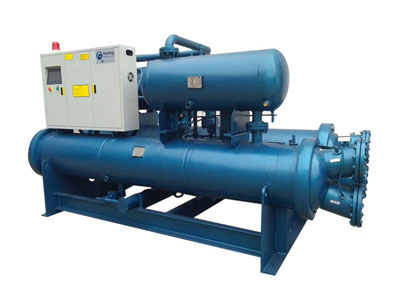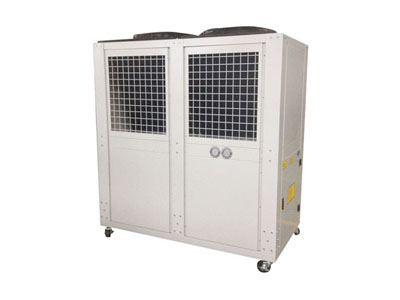How Do Industrial Water Chillers Work?
If your facility uses heat generating process fluids or heavy machinery, you will need an industrial chiller system to cool your process and internal machine components. Understanding how industrial chillers work and the various types of chillers available will help you make the right choice for your cooling needs.
What is a chiller?
An industrial chiller is a refrigeration system used to reduce the temperature of machinery, industrial spaces and process fluids by removing heat from the system and transferring it elsewhere. Industrial chillers are essential for temperature regulation in a number of industrial processes such as injection moulding, metal plating, oilfield production and food processing.
Why use a chiller?
Industrial chiller systems are beneficial for applications that require tight operating temperatures. When integrated with heat sensitive processes, the chillers will prevent thermal damage to process equipment and ensure that the end product is not altered by exposure to unsuitable temperatures.

Flooded Type Screw Type Chiller
Principle of operation
Industrial chillers work on the following operating principles.
Phase change: When heated, the liquid coolant undergoes a phase change into a gas, when the gaseous coolant is supercooled it condenses back into a liquid.
Heat flow: Heat always flows from areas of high concentration to areas of low concentration.
Boiling point: lowering the pressure of a liquid lowers its boiling point, increasing the pressure raises its boiling point.
How do chillers work?
Industrial chiller systems are driven by one of two operating principles.
Heat absorption
Vapour compression

Air-Cooled Chiller
Heat-absorbing chillers incorporate a heat exchanger that removes heat from any associated process and distributes it to the outside. The heat exchanger usually consists of a pipe containing a cooling fluid (air, water or a mixture of water and other liquids).
A vapour compression cooler achieves its cooling effect by circulating coolant in the pipes in the process to be cooled. This absorbs heat from any associated processes into the coolant, which is then circulated to the refrigeration system, which cools the coolant and prepares it for a new process cooling cycle.
The chiller consists of four basic components; the evaporator, the compressor, the condenser and the expansion unit. In addition, each chiller system contains a refrigerant.
The process starts with a low pressure refrigerant entering the evaporator. Inside the evaporator, the chiller refrigerant is heated, causing it to undergo a phase change into a gas. Next, the gaseous refrigerant enters the compressor, thereby increasing its pressure.
A dilute solution of coolant and absorbent flows through the heat exchanger to the generator, where it is heated. The coolant evaporates from the solution, condenses and is then sent out again for cooling. The concentrated absorbent is now also recycled.
Glycol chillers
Glycol chillers are a special type of system in which propylene glycol (an antifreeze) is used. They are widely used in food-grade applications, such as alcohol production and brewery cooling systems.
How do glycol chillers work?
Glycol chillers operate in the same way as standard chillers.
Centrifugal chillers
Centrifugal chillers consist of the usual evaporator, compressor, condenser and expansion unit, but with an additional rotating impeller that compresses the refrigerant and transports it around the system. They are beneficial for medium to large cooling operations (from 150 to 6000 tonnes of refrigeration).
What is a chiller?
An industrial chiller is a refrigeration system used to reduce the temperature of machinery, industrial spaces and process fluids by removing heat from the system and transferring it elsewhere. Industrial chillers are essential for temperature regulation in a number of industrial processes such as injection moulding, metal plating, oilfield production and food processing.
Why use a chiller?
Industrial chiller systems are beneficial for applications that require tight operating temperatures. When integrated with heat sensitive processes, the chillers will prevent thermal damage to process equipment and ensure that the end product is not altered by exposure to unsuitable temperatures.

Flooded Type Screw Type Chiller
Principle of operation
Industrial chillers work on the following operating principles.
Phase change: When heated, the liquid coolant undergoes a phase change into a gas, when the gaseous coolant is supercooled it condenses back into a liquid.
Heat flow: Heat always flows from areas of high concentration to areas of low concentration.
Boiling point: lowering the pressure of a liquid lowers its boiling point, increasing the pressure raises its boiling point.
How do chillers work?
Industrial chiller systems are driven by one of two operating principles.
Heat absorption
Vapour compression

Air-Cooled Chiller
Heat-absorbing chillers incorporate a heat exchanger that removes heat from any associated process and distributes it to the outside. The heat exchanger usually consists of a pipe containing a cooling fluid (air, water or a mixture of water and other liquids).
A vapour compression cooler achieves its cooling effect by circulating coolant in the pipes in the process to be cooled. This absorbs heat from any associated processes into the coolant, which is then circulated to the refrigeration system, which cools the coolant and prepares it for a new process cooling cycle.
The chiller consists of four basic components; the evaporator, the compressor, the condenser and the expansion unit. In addition, each chiller system contains a refrigerant.
The process starts with a low pressure refrigerant entering the evaporator. Inside the evaporator, the chiller refrigerant is heated, causing it to undergo a phase change into a gas. Next, the gaseous refrigerant enters the compressor, thereby increasing its pressure.
A dilute solution of coolant and absorbent flows through the heat exchanger to the generator, where it is heated. The coolant evaporates from the solution, condenses and is then sent out again for cooling. The concentrated absorbent is now also recycled.
Glycol chillers
Glycol chillers are a special type of system in which propylene glycol (an antifreeze) is used. They are widely used in food-grade applications, such as alcohol production and brewery cooling systems.
How do glycol chillers work?
Glycol chillers operate in the same way as standard chillers.
Centrifugal chillers
Centrifugal chillers consist of the usual evaporator, compressor, condenser and expansion unit, but with an additional rotating impeller that compresses the refrigerant and transports it around the system. They are beneficial for medium to large cooling operations (from 150 to 6000 tonnes of refrigeration).
评论
发表评论